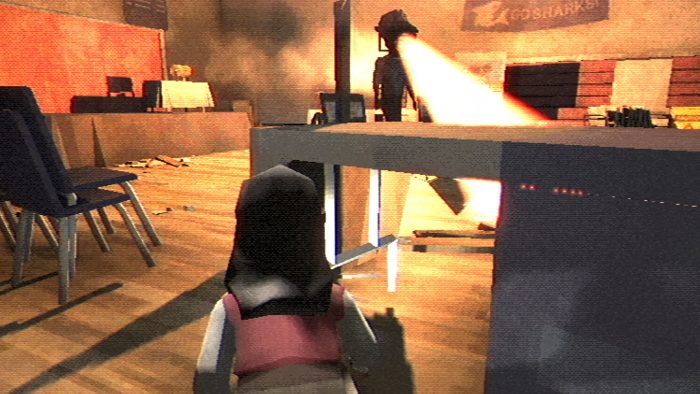Classic inspiration, modern horror with Blumhouse Games’ first title
I’m not the biggest horror game fan, mostly because the genre had become almost too focused on zombies and jump scares, but I AM a fan of modern horror films. Thankfully the game genre has taken a turn over the last few years into some truly interesting gameplay and narrative work. When Blumhouse announced that they were getting into games, my mind immediately became intrigued for what they would be able to bring to the genre. Would it stretch and be as innovative and blur lines like their films?
My hands-on with their first project, developer Cozy Game Pals’ Fear the Spotlight, answers that question with a very loud and creaky “YES.”
The game takes place in a town still dealing with the pains of a school-engulfing fire in its past. Two friends are sneaking in the school after dark, now decades later and fully rebuilt, to borrow the OUIJA board for a “harmless” play session.
My demo picks up as the two had just broken into the school and have to make their way to the library. I’m immediately struck by the project’s aesthetic, which takes 90s era chunky polygonal designs and adds a grainy VHS filter on top. The filter, I find out, can be turned on and off, depending on how much we can see or are willing to accept. It’s very purposefully rough a first, but my brain quickly adjusts and I’m able to start moving around the hallways. Controls are familiar, with the girls walking around and interacting with objects like signs and doors. There’s no real combat in the game; it’s heavy on being an adventure that puts exploration and interaction at the forefront.
As I walk around the hallways, I get the feeling that the game’s lead is trying to impress her friend, and is willing to break a few rules (and maybe some light laws) to get into her good graces. The movement is slow — the pair *is* walking — with the ability to crouch or go into a very light jog as my other traversal options. We pass by lockers, classroom doors, and signs for after hour clubs, all while things seem a little eerie. It’s dark, it’s foreboding, and there’s a thickness in the air. We need to avoid the school cameras to make sure we don’t get caught, and we must sneak through doors at just the right time.
Because this is an adventure game, we have a lot of small chase tasks in which we need to find something to activate or open something else, but in order to find that thing (like a key) we first need to do a separate task all-together. The layering should be familiar to anyone who’s played an adventure game before, as nothing is immediately easy. Some of the tasks are puzzles, and some of them are just movement based. Some rely on timing or even stillness, like holding a button down to place our fingers on the OUIJA’s planchette and waiting for something to happen.

Oh, and something DOES happen. Things get weird. QUICK. The game knows it needs to keep our attention, so the strangeness rampes up to the point where we start seeing things, hearing things, experiencing things. At one point we need to find our way through some knocked over shelves, but they’ve been strategically placed so that we’re linear and guided towards the goal, all while hearing things happen behind and in front of us as set times. Having the headphones on is a must, because so much of the game is built on sound cues and conversation.
The demo is only about a half hour total, but during that time I move from teenage mischief to psychological and paranormal horror. In fact, in one point during the demo I fell victim to a sort of jump scare that managed to affect me even in an extremely well lit room.
Fear the Spotlight is bathed in paranormal themes that use nineties designs as both narrative and visual elements, and modern psychological horror in its plot layering, to draw us in deep. It was a half hour, but it was the kind of half hour that feels like the first episode of great new horror show that we’d get together around the water cooler for each week.
Fear the Spotlight arrives later this year on everything, and I can’t wait to experience the full depth of what it has to say.


No Comments